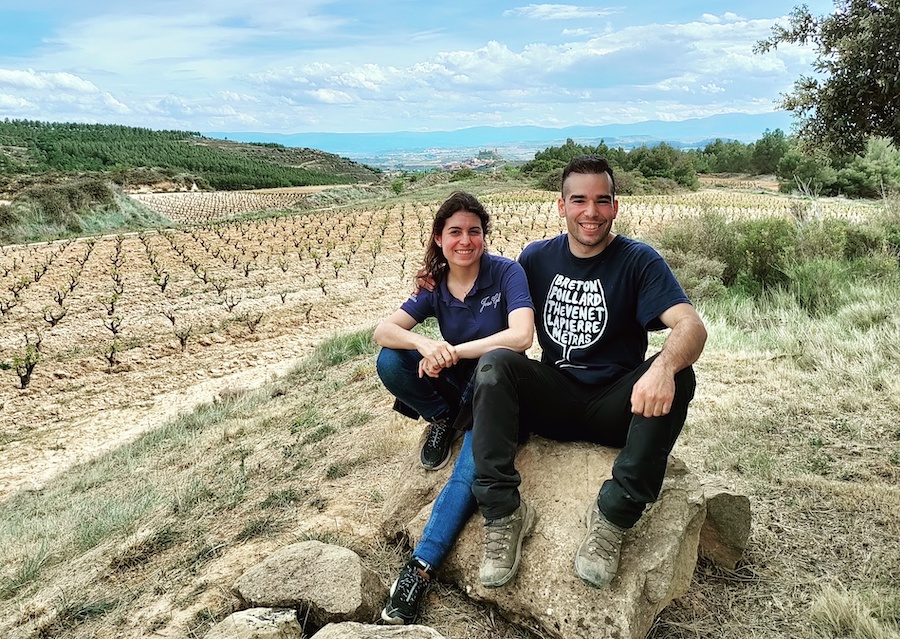Vignerons de la Sonsierra - José Gil
Travesía Calvo Sotelo, 7. 26338 San Vicente de la Sonsierra (La Rioja)

A third-generation winegrower from San Vicente de la Sonsierra, José Gil seemed destined to work in the world of wine. After completing his studies in oenology in Logroño in 2010, he began working at Olmaza, the family winery. But rather than settle into a comfortable role, he decided to forge his own path.
His grandfather Ángel had always been a source of inspiration —both in the way he tended the vineyards and in his intuitive feel for wine. But José wanted to go beyond producing good cosechero wines from such special vineyard sites as La Cóncova or the slopes of one of the seven valleys with varying orientations and soils found in San Vicente de la Sonsierra. This village perched above the Ebro River boasts almost as many vineyard hectares as the entire DOQ Priorat.
Little by little, José began buying parcels in San Vicente, experimenting with small-scale, garage-style winemaking while taking time to travel to other wine regions and broaden his horizons. In 2012, he purchased and restored La Cueva del Espino, a small medieval cellar tucked into the northern slope of the castle hill —just two doors down from Benjamín Romeo’s— and by 2016 he released his first 2,000 bottles of La Cóncova.
A turning point came in 2018 when he met his partner, Vicky Fernández. Originally from Uruguay and living in Bilbao, Vicky came from a hospitality background but quickly caught the wine bug. Since then, the couple have shared all the work involved in their joint project, Vignerons de la Sonsierra.
In 2021, they stopped selling grapes to Olmaza and significantly increased their own production. They eliminated herbicides from the vineyards and embraced organic farming, although without official certification.
Vicky and José cultivate 10 hectares in San Vicente and Labastida, which they bottle under their own label. They also farm an additional 2.5 hectares in Briones, whose grapes are sold to Allende. Alongside their neighbour Miguel Eguíluz (Cupani) and other like-minded local producers such as Ricardo Fernández (Abeica), Miguel Merino, Álvaro Loza, Carlos Sánchez, and sommelier Iván Sánchez (Venta Moncalvillo), they are part of Martes of Wine —a group that not only blind tastes wines from around the world and travels to other regions, but also exchanges ideas and supports one another.
The wines
The couple currently produce five red wines —all Tempranillo-based with small amounts of Viura, Garnacha, and other varieties found in the vineyards— as well as one white. Their philosophy is to make fresh wines that express the terroir and the character of each vineyard they work.
The range begins with two village wines. José Gil Viñedos en San Vicente (16,000 bottles, €27.50) is sourced from several sites at varying elevations and orientations. Fermented with 25% whole bunches, the wine is aged for 10 months in concrete and then for 11 months in used 500-litre French oak casks. The winemaking is similar for José Gil Viñedos en Labastida (5,000 bottles, €27.90), although in this case the ageing takes place exclusively in 500-litre casks. The fruit comes from old vines in this Alavese village, where the soils are sandier than in San Vicente and the Garnacha content is higher— reaching up to 35% in the 2024 vintage. The Labastida wine shows a less austere profile compared to its San Vicente counterpart.
The two single-site wines are José Gil Paraje El Bardallo and José Gil Paraje La Canoca (3,300 bottles each, €42.90). The former comes from three parcels within this clay-limestone site, whose name is shared with other producers such as Abeica and 3 Viñerones, something quite unusual in Rioja. El Bardallo is fermented with 15% whole bunches in concrete and aged for 11 months in 500-litre casks. Following a similar process, La Canoca comes from three terraced parcels at elevations ranging from 645 to 700 metres, with varying exposures and soils of clay, silt, and sand.
The elegant and complex Camino de Ribas (2,500 bottles, €65) is sourced from a single vineyard within La Cóncova site and blends 80% Garnacha, 10% Tempranillo, and 5% Garnacha Blanca. It ferments with 35% whole bunches in concrete and, like the other single-site wines, is aged for 11 months in 500-litre casks.
Their new white, El Calado del Espino (1,350 bottles, €43), comes from an old Viura vineyard in Labastida with limestone soils, as well as a portion from Bardallo. 70% of the wine is fermented in 500-litre French oak barrels, with the rest aged in 54-litre demijohns. Long on the palate with a delightful saline touch, this is a wine that will evolve and refine beautifully in bottle.
A firm believer in traditional bush-trained vines, José sees them as best suited to the region. “San Vicente,” he says, “is actually one of the villages with the most traditional vineyard plantings.”
Most popular
NEWSLETTER
Join our community of Spanish wine lovers


